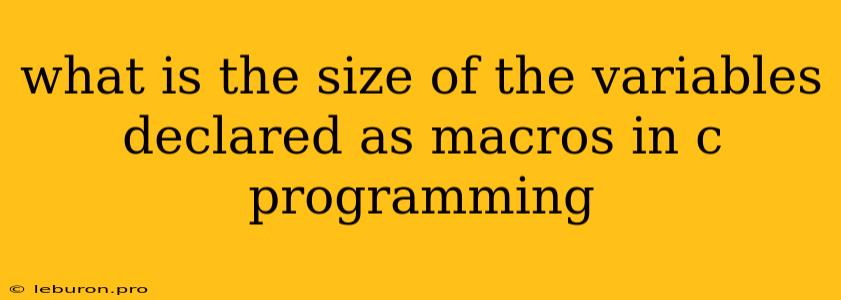In the realm of C programming, macros are powerful tools that enable code reusability and optimization. They act as textual replacements, allowing developers to define symbolic names for constants, expressions, or even entire code blocks. While macros offer numerous benefits, understanding their impact on variable size is crucial for efficient memory management and program performance. This article delves into the intricacies of variable size when declared as macros in C, shedding light on the subtle nuances and considerations involved.
Understanding Macros and Variables
Before diving into the specifics of variable size in macros, let's establish a clear understanding of these fundamental concepts.
Macros in C are essentially preprocessor directives that instruct the compiler to replace a macro identifier with its defined content before actual compilation. This substitution happens during the preprocessing stage, effectively eliminating the original macro declaration from the source code.
Variables, on the other hand, represent memory locations that store data. Their size depends on the data type they hold. For example, an integer variable typically occupies 4 bytes, while a floating-point variable might require 8 bytes.
The Relationship Between Macros and Variable Size
The key point to grasp is that macros themselves do not directly allocate memory. They are merely placeholders that get replaced with their corresponding content before the compiler analyzes the code. Therefore, the size of variables declared as macros is determined by the data type they represent within the macro's definition.
Example:
Consider a macro defining a constant value:
#define MAX_SIZE 100
Here, MAX_SIZE is the macro identifier. It gets replaced by the value 100 during preprocessing. This value is not a variable; it's simply a constant. Hence, its size is not determined by a data type but by the value itself, which is represented in binary form.
Macro Expansion and Variable Size
Let's examine how the size of a variable is determined within a macro expansion:
#define ARRAY_SIZE 10
int array[ARRAY_SIZE];
In this case, the macro ARRAY_SIZE gets replaced with the value 10 during preprocessing. The code after expansion becomes:
int array[10];
Now, array is declared as an integer array of size 10. The size of each element in the array is determined by the data type int, which typically occupies 4 bytes. Therefore, the total memory allocated for the array is 10 elements * 4 bytes/element = 40 bytes.
Key Considerations
Several factors contribute to the size of variables declared as macros, warranting careful attention:
- Data Type: The underlying data type of the variable within the macro definition dictates its size.
- Preprocessing Stage: Macros are expanded during preprocessing, affecting how the compiler interprets and allocates memory.
- Scope: Macros are typically defined globally, meaning their content is available throughout the program.
Conclusion
Macros, while powerful for code optimization and reusability, do not directly allocate memory for variables. The size of variables declared within macros depends on the data type and the macro's expansion during preprocessing. It is crucial to understand this distinction to write efficient and predictable C code. By carefully considering the size implications of macros, developers can effectively manage memory resources and ensure optimal program performance.
